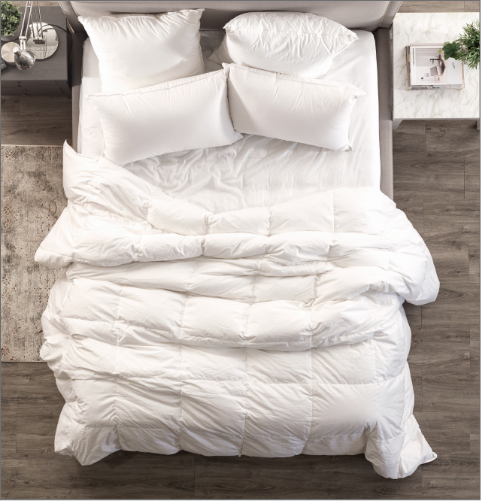The key with duvet construction is achieving an even distribution of the fill (AKA warmth!). And depending which duvet fill you go for, there are a few
different techniques to choose from. With down duvets, there are two main types of construction: baffle box and stitch box. Both are pretty much what they sound
like!
Baffle box construction involves a series of “boxes” created by stitching internal walls of fabric inside a duvet. These boxes allow down to loft to its full
extent and remain evenly distributed, preventing any cold spots. So this technique is perfect for colder sleepers, cooler weather, or anyone who likes an even
feeling of warmth.

Prestige Duvet - Baffle Box Construction
Stitch box construction also involves a series of boxes or pockets for the down. The difference is, these pockets are created by stitching directly through the
top and bottom layers of the duvet shell. With this method, down may be scarce along the sew lines, creating some cool spots and a more sculpted look. But if
you sleep on the warm side, this can be an advantage!

Chinook Duvet - Stitched Box Construction
Our silk duvets use either stitch box, ring stitch, or even, hand stitch construction. Ring stitch involves a series of small rings stitched into the top and
bottom layer of the duvet, which prevents the silk floss from shifting. However, like stitch box construction, silk floss may be scarce along sew lines. So
again, this method may be better for warmer sleepers or climates.

Meridian Duvet - Ring Stitching
Only our most premium silk duvet is hand stitched to create a series of evenly spaced loops throughout the top and bottom of the duvet. This secures the silk
floss and creates a perfectly even layer of warmth. Like baffle box construction, there are no cold spots with this method.

Fortuna Duvet - Hand Stitching
Only our most premium silk duvet is hand stitched to create a series of evenly spaced loops throughout the top and bottom of the duvet. This secures the silk
floss and creates a perfectly even layer of warmth. Like baffle box construction, there are no cold spots with this method.
What about the fabric shell of a duvet?
Also known as the “ticking”, the fabric shell of a duvet contributes to your overall comfort! There are a couple factors to consider here, first being the
thread count. Anything above 220TC will be down-proof ー and rest assured, all our duvets meet this criteria.
The higher the thread count, the softer and lighter the shell. Softness isn’t as big a concern, as you’ll be using a duvet cover. But a lighter shell will allow
down or alternative fills to achieve greater loft and a fluffier look.
Second, consider the fabric! Most of our duvets are made with breathable, 100% cotton shells, woven in a sateen or jacquard. A sateen shell will be a little
lighter, while a jacquard adds more weight and warmth to a duvet.

Jacquard Shell

Sateen Shell
We also have natural alternatives, like bamboo. Our bamboo duvets are made with 100% bamboo rayon shells. These shells are slightly less breathable than cotton,
but they have excellent moisture-wicking properties.
In the end, a duvet shell isn’t quite as important as the fill. But understanding what makes a shell down-proof, how different weaves affect warmth and weight,
and which fabrics breathe best can help inform your decision!















